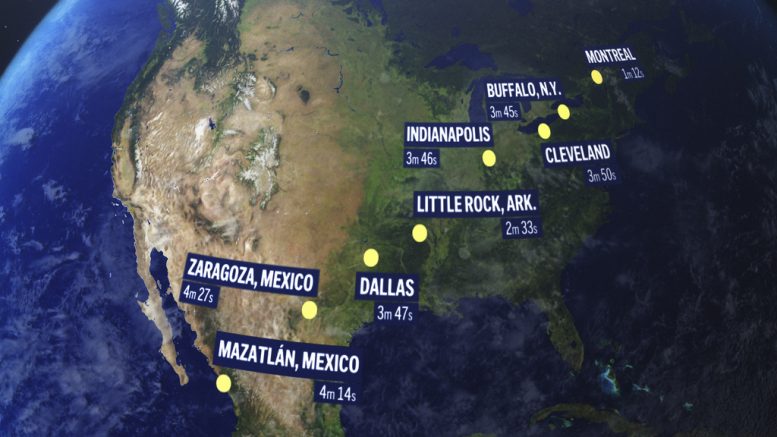MESQUITE, Texas (AP) — Millions of spectators along a narrow corridor stretching from Mexico to the U.S. to Canada eagerly awaited Monday’s celestial sensation — a total eclipse of the sun — even as forecasters called for clouds.
The best weather was expected at the tail end of the eclipse in Vermont and Maine, as well as New Brunswick and Newfoundland.
It promised to be North America’s biggest eclipse crowd ever, thanks to the densely populated path and the lure of more than four minutes of midday darkness in Texas and other choice spots. Almost everyone in North America was guaranteed at least a partial eclipse, weather permitting. The show gets underway in the Pacific shortly before noon EDT.
In Texas, the south-central region was locked in clouds, but it was a little bit better to the northeast, said National Weather Service meteorologist Cody Snell.
“Dallas is pretty much a 50-50 shot,” he said.
The cliff-hanging uncertainty added to the drama. Rain or shine, “it’s just about sharing the experience with other people,” said Chris Lomas from Gotham, England, who was staying at a sold-out trailer resort outside Dallas, the biggest city in totality’s path.
Sarah Laneau, of Westfield, Vermont, woke up at 4 a.m. Monday to bring her 16-year-old daughter to nearby Jay Peak ski resort to catch the eclipse from the top of the mountain after a morning on the slopes.
“This will be a first from me and an experience of a lifetime,” said Laneau, who was dressed in a purple metallic ski suit with a solar eclipse T-shirt underneath.
For Monday’s full eclipse, the moon was due to slip right in front of the sun, entirely blocking it. The resulting twilight, with only the sun’s outer atmosphere or corona visible, would be long enough for birds and other animals to fall silent, and for planets, stars and maybe even a comet to pop out.
The out-of-sync darkness lasts up to 4 minutes, 28 seconds. That’s almost twice as long as it was during the U.S. coast-to-coast eclipse seven years ago because the moon is closer to Earth. It will be another 21 years before the U.S. sees another total solar eclipse on this scale.
Extending five hours from the first bite out of the sun to the last, Monday’s eclipse begins in the Pacific and makes landfall at Mazatlan, Mexico, before moving into Texas, Oklahoma, Arkansas and 12 other U.S. states in the Midwest, Middle Atlantic and New England, and then Canada. Last stop: Newfoundland, with the eclipse ending in the North Atlantic.
It will take just 1 hour, 40 minutes for the moon’s shadow to race more than 4,000 miles (6,500 kilometers) across the continent.
Eye protection is needed with proper eclipse glasses and filters to look at the sun, except when it ducks completely out of sight during an eclipse.
The path of totality — approximately 115 miles (185 kilometers) wide — encompasses several major cities this time, including Dallas, Indianapolis, Cleveland, Buffalo, New York and Montreal. An estimated 44 million people live within the track, with a couple hundred million more within 200 miles (320 kilometers). Add in all the eclipse chasers, amateur astronomers, scientists and just plain curious, and it’s no wonder the hotels and flights are sold out and the roads jammed.
Experts from NASA and scores of universities are posted along the route, poised to launch research rockets and weather balloons, and conduct experiments. The International Space Station’s seven astronauts also will be on the lookout, 270 miles (435 kilometers) up.
































